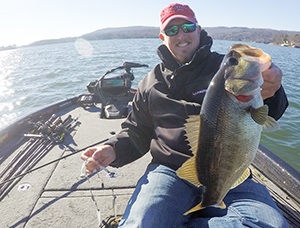 YUMbrella Rigs producing big results on a December day at Lake Guntersville wasn’t surprising. Far from it, in fact. The surprise to veteran Tennessee River guide and bass pro Jimmy Mason was that 13 of the first 15 bass he and I caught had taken one of rig’s the outside baits.
YUMbrella Rigs producing big results on a December day at Lake Guntersville wasn’t surprising. Far from it, in fact. The surprise to veteran Tennessee River guide and bass pro Jimmy Mason was that 13 of the first 15 bass he and I caught had taken one of rig’s the outside baits.
“Normally, about 70 percent of what we catch is on the center one, which is slightly back from the others,” Mason said.
The difference? We had gotten ahold of a couple of packages of the new 3.5-inch YUM Pulse swimbaits, which hadn’t been released at that time, and Mason had put downsized swimbaits on all the outside jigheads and one of the original 4.5-inchers in the center. Seemingly the fish we relating enough to smaller forage that they strongly favored the smaller baits over even the trailing bait.
I had been excited about new smaller Pulse from the day I’d learned it would be coming out and was absolutely sold during that day on Guntersville. In the 10 months since, I’ve repeatedly had my initial excitement affirmed in a variety of settings and for a host of freshwater and saltwater species.
With leaves and temperatures falling across much of bass country, we’re moving into what promises to be an extra good season for the 3.5-inch Pulse for largemouths, smallmouths and spotted bass. During fall, huge schools of shad move up into creek arms of reservoirs, and big numbers of bass, understandably, follow the shad. The most productive lures at this time almost invariably suggest shad.
The YUM Pulse is a slender-profiled, ribbed swimbait that has a thumping tail action and a distinctive roll as it comes through the water. The new smaller version provides an extra natural shad imitation for fall fishing, because the real baitfish tend to be small this time of year.
One real virtue of a swimbait for fall fishing is its versatility. Baitfish and bass move a lot this time of year and can be up on flats or down in channels. A Pulse can be fished with equal effectiveness only inches from the surface or near the bottom in 25 feet. It also can be worked quickly or slowly and is effective in open water or around weedbeds or other cover.
For open-water, simple jighead rigging provides the highest hook-up ratios. A round head or dart head jig is a good option, with useful sizes ranging from about 1/16 to ½ ounce. The target depth range, any presence of wind or current, and presentation speeds all play a part in picking the best weight. For extra flash, an underspin head can be quite effective.
For fishing the same bait through grass or brush, good options include a weedless rigging with a belly-weighted swimbait hook or Texas rigging with just enough weight to provide a bit of stability and enhanced castablity.
Whether rigged open or weedless, the essence of fishing a Pulse is as simple as it gets. Cast it out. Reel it back. However, that can mean casting to schooling fish with a fairly heavy jighead and reeling ultra-fast to keep the bait shallow and prompt reaction strikes or using a light jighead and reeling only enough to keep the lures tail wiggling. Fall offers opportunities for both extremes and everything in-between so it’s important to gauge conditions, pay attention to signs, experiment and allow fish to dictate how they want the bait presented.
Of course as fall progresses and begins giving way to winter and the shad start suspending, it’ll be time to break out those YUMbrella Rigs for presenting both sizes of Pulse swimbaits.
